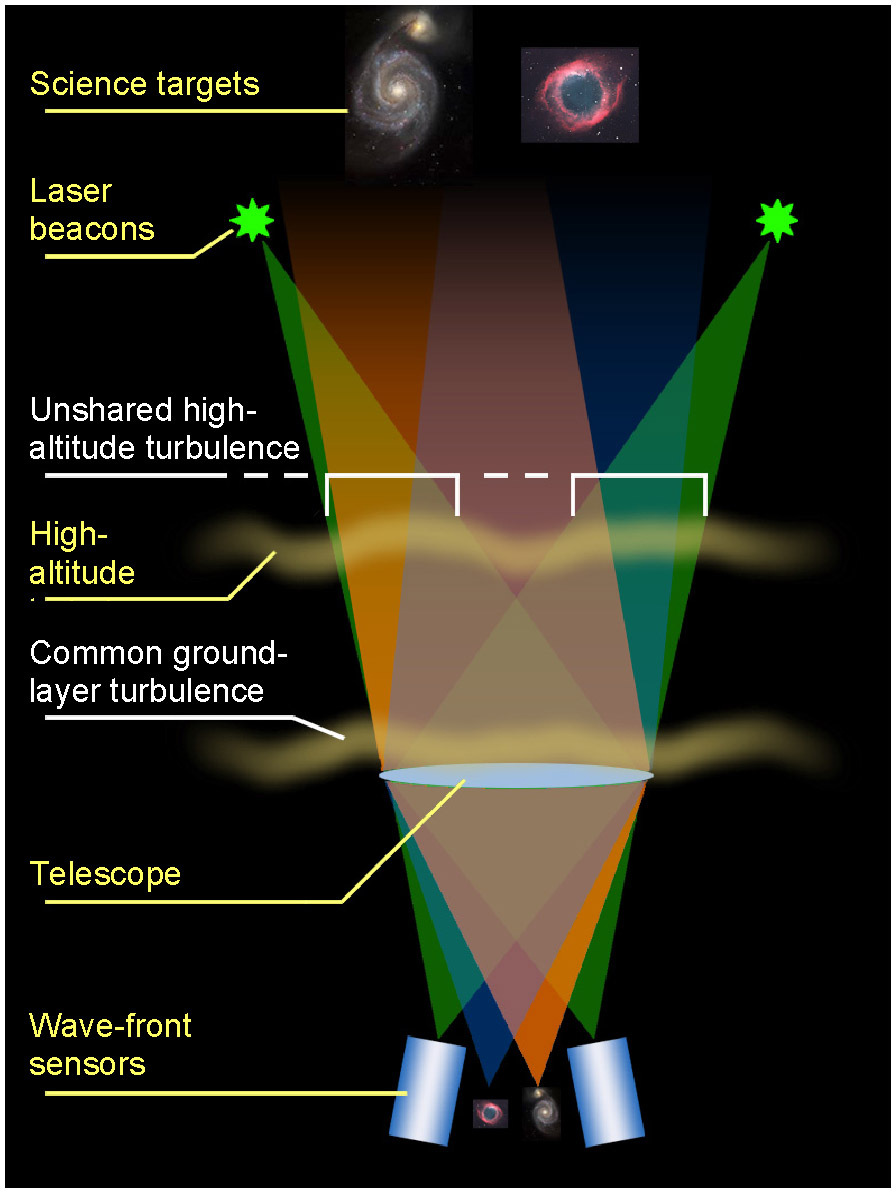Which of the Following Telescopes Benefits Most From Adaptive Optics
A The Keck I Telescope on Mauna Kea. Observatory X can detect dimmer stars and Observatory Y reveals more detail in images.

Adaptive Optics An Overview Sciencedirect Topics
In simple terms the best I can offer an adaptive optic telescope shines a laser at the part of the sky it is attempting to view photograph.

. What is the purpose of adaptive optics. Which of the following telescopes benefits most from adaptive optics. Observatory X consists of a single 50-meter telescope.
Observatory Y is an interferometer consisting of five 10-meter telescopes spread out over a region 100 meters across. Currently the largest optical telescope mirrors have a diameter of -10 m. The Hubble Space telescope.
This bit of magic is performed by something called a wave-front corrector. The Keck I Telescope on Mauna Kea. The Chandra X-ray Observatory.
Adaptive optics refers to a system in which the image being received through a telescope is analyzed in more-or-less real time for distortion caused by seeing and an inverse distortion is applied to the telescope optics to remove or reduce the effect. Observatory Y is an interferometer consisting of five 10. Observatory X consists of a single 50-meter telescope.
In the May 2016 issue of Sky Telescope author Shannon Hall covers the past present and future of adaptive optics AO the technology that has allowed astronomers to conquer the tempestuous atmosphere. Experience with design development test and operations of adaptive optics control systems at large telescope facility. A The Keck I Telescope on Mauna Kea.
The Keck I telescope on MaunaKea. The reflected laser image is analyzed giving. Ability to travel to and spend time at partners location working with the partner or vendor software development team.
-to eliminate the distorting effects of atmospheric turbulence for telescopes on the ground. Which of the following telescopes benefits most from adaptive optics. Consider two future observatories in space.
Which of the following telescopes would benefit most from adaptive optics. The Arecibo radio telescope inPuerto Rico. Which of the following telescopes benefits most from adaptive optics.
Hammel and Imke de Pater. C The Arecibo Radio Telescope in Puerto Rico. Adaptive optics are used with massive reflecting telescopes the workhorses of modern astronomy.
Which of the following telescopes would benefit most from adaptive optics. -It allows two or more telescopes to obtain the angular resolution of a single telescope much larger than any of the individual telescopes. A The Keck I Telescope on Mauna Kea.
Observatory X consists of a single 50-meter telescope. Observing objects with space-based telescopes can avoid the disruptive effects of the atmosphere and astronomers using Earth-based telescope have turned to a method called adaptive optics to compensate for atmospheric light-bending. The Keck I telescope on Mauna Kea Consider two future observatories in space.
Observatory X consists of a single 50-meter telescope. Which of the following will be most useful to have. Which of the following telescopes would benefit most from adaptive optics.
AO also mitigates optical signal fades and precisely couples both ends of the communications link thereby optimizing the signal-to-noise ratio. A The Arecibo radio telescope in Puerto Rico B The Hubble Space telescope C The Keck I telescope on Mauna Kea D The Chandra X-ray Observatory C Consider two future observatories in space. The project office is located in Monrovia and residence in the area is required.
B The Hubble Space Telescope. Besides its use for improving nighttime astronomical imaging and retinal imaging adaptive optics technology has also been used in other settings. Stars basically remain pin points even to telescopes.
2 points QUESTION 91. Which of the following telescopes would benefit most from adaptive optics. Answer 1 of 2.
Which of the following best describes the development of astronomical telescopes over the past 60 years. It is closer to the stars. A major benefit of AO technology is that it allows coupling of a received laser beam which has traversed through.
The Arecibo radio telescope in Puerto Rico The Chandra X-ray Observatory The Keck I telescope on Mauna Kea The Hubble Space telescope The Keck I telescope on Mauna Kea 39 Consider two future observatories in space. D The Chandra X-Ray Observatory. Observatory X consists of a single 50-meter telescope.
It is also expected to play a military role by allowing ground-based and airborne laserweapons to r. Adaptive optics is used for solar astronomy at observatories such as the Swedish 1-m Solar Telescope and Big Bear Solar Observatory. The effect of adaptive optics is immediately visible and astounding so were including here a full.
Consider two future observatories in space. Which of the following telescopes benefits most from adaptive optics. QUESTION 8 1.
The Keck I telescope on Mauna Kea. Consider two future observatories in space.

Adaptive Optics Enhances Power Of Astronomical Telescopes
A Simplified Overview Of An Adaptive Optics System The Wavefront Download Scientific Diagram
Do All Large Earth Based Telescopes Created More Recently Use Adaptive Optics Ao What Was The Last Large Telescope That Didn T Have Ao Quora
How Do Ground Based Telescopes With Adaptive Optics Compare To The Hubble Space Telescope Quora
No comments for "Which of the Following Telescopes Benefits Most From Adaptive Optics"
Post a Comment